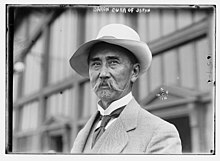Ōura Kanetake
Ōura Kanetake ( Japanese 大 浦 兼 武 ; * June 15, 1850 ( Gregorian ) / May 6, Kaei 3 ( contemporary ) in Kagoshima ; † September 30, 1918 in Tokyo ) was a Japanese politician .
Life
Officer and promotion to Tokyo Police Commissioner
Ōura Kanetake, son of a samurai from the principality (han) Satsuma or Kagoshima (from 1871 prefecture (ken) Kagoshima ), ruled by the Shimazu clan , took part in the Boshin War between the Tokugawa - Shogun and the Satsuma- Chōshū - between 1868 and 1869 Restoration Alliance, which was militarily the forerunner of the Imperial Army , politically of the henceforth ruling Meiji oligarchy . The victory of the Restoration troops paved the way for a transformation of society in the course of the Meiji Restoration . He then joined the police service, which was then part of the prefectural authorities subordinate to the Ministry of the Interior ( Naimu-shō ) , and was transferred to the Tokyo Police Department ( Keishi-chō ) , which was founded on January 15, 1874 , where he was promoted to inspector in 1875 took place. As a lieutenant in the Imperial Army, he took part in the crackdown on the Satsuma Rebellion in 1877 , the last and largest of a series of uprisings against the new government. On February 2, 1882, he was appointed police chief of Osaka Prefecture and held this post until December 25, 1886, whereupon Takasaki Chikaaki became his successor. In 1888 he became deputy head of the police department of the Ministry of the Interior and thus representative of department head Kiyoura Keigo .
Subsequently, Ōura was governor of Shimane prefecture between 1893 and 1895, governor of Yamaguchi prefecture from 1895 to 1896, governor of Kumamoto prefecture between 1896 and 1898 and governor of Miyazaki prefecture in 1898 . He was then appointed general superintendent of the Tokyo Police Department in 1898 and a member of the Upper House ( Kizokuin ) of the Reichstag (Teikoku-gikai) on March 19, 1900 .
Minister and resignation because of the "Ōura scandal"
On September 22, 1903 Ōura Kanetake took over the post of communications minister (Teishin-daijin) in the first Katsura cabinet as the successor to Sone Arasuke and held this until January 7, 1906. In the second Katsura cabinet he held between July 14, 1908 and his Replacement by Komatsubara Eitarō on March 26, 1910 for the first time as Minister of Agriculture and Trade (Nōshōmu-daijin) . He served as president of the Japan-British Exhibition , from 14 May to 29 October 1910 international exhibition, the largest of the Japanese Empire on the exhibition grounds Great White City in London's White City was held. On September 3, 1910, he again replaced Komatsubara Eitarō and served again as Minister of Agriculture and Trade until August 30, 1911. In the third cabinet, Katsura , he served as Interior Minister ( Naimu-daijin ) between December 21, 1912 and February 20, 1913 . On December 23, 1913 he supported Katsura Tarō and Katō Takaaki in founding the Association of Friends of the Constitution (English for the [Rikken] Dōshikai , about "[constitutional] association of like-minded people / friends").
In the second Ōkuma cabinet he was again Minister of Agriculture and Trade from April 16, 1914 until his replacement by Kōno Hironaka on January 7, 1915. He himself then succeeded Ōkuma Shigenobu as Minister of the Interior and now held this office until his resignation on July 30, 1915, after which Ōkuma Shigenobu took over again. The reason for his resignation were allegations of electoral fraud in the so-called "Ōura scandal" (Ōura jiken) , in which he had funds from the Rikken Dōshikai distributed to MPs via the Secretary of the Lower House, Hayashida Kametarō, so that they could be used for the military budget submitted by the Ōkuma cabinet and the expansion of the Imperial Army to vote for two divisions. On August 3, 1915, he also resigned from the House of Lords.
Ōura Kanetake, who was raised to the hereditary nobility ( Kazoku ) as vice count (Shishaku) , was also president of the Greater Japan Martial Arts Association ( Dainippon Butokukai ) .
Background literature
- Sheldon Garon: The State and Labor in Modern Japan , University of California Press, 1987, ISBN 0-5209-0980-1
- Junji Banno: The Establishment of the Japanese Constitutional System , Routledge, 2003, ISBN 1-1347-8096-6
- Christopher Keaveney: The Cultural Evolution of Postwar Japan: The Intellectual Contributions of Kaizō's Yamamoto Sanehiko , Springer, 2013, ISBN 1-1373-6411-4
- Dimitri Vanoverbeke: Juries in the Japanese Legal System: The Continuing Struggle for Citizen Participation and Democracy , Routledge, 2015, ISBN 1-3174-8733-8
Web links
- Entry in Portraits of Modern Japanese Historical Figures
- The Governments of Japan 1885-1945
Individual evidence
- ↑ National Parliamentary Library : Kindai nihonjin no shōzō , "Portraits of Modern Japanese Historical Figures", Ōura Kanetake ( Japanese , English )
- ↑ Denis Gainty: Martial Arts and the Body Politic in Meiji Japan , p. 45, Routledge, 2013, ISBN 1-1350-6990-5
| personal data | |
|---|---|
| SURNAME | Ōura, Kanetake |
| ALTERNATIVE NAMES | 大 浦 兼 武 (Japanese) |
| BRIEF DESCRIPTION | Japanese politician |
| DATE OF BIRTH | June 15, 1850 |
| PLACE OF BIRTH | Kagoshima |
| DATE OF DEATH | September 30, 1918 |
| Place of death | Tokyo |

